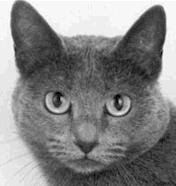The distinguishing feature of the Russian Blue is its double coat, which has a plushness that is unrivalled by any other cat. Probably the most famous, and certainly the most cosseted, example of the breed is Vashka, who was owned by Tsar Nicholas I of Russia – where these cats are considered a welcome omen of good luck.
History
The variety of names that the Russian Blue has had bears witness to be confusion surrounding its origins. The evidence s strong for its being a natural Russian breed, evidence that is supported by the large numbers that have long been found in Sweden; but its subsequent history is much less certain. It was known at first as the Archangel Cat because examples were brought back to Britain from the Russian port of Archangelsk by Elizabethan sailors. Later, it was known as both the Spanish Cat and the Maltese Cat, the latter name persisting in the US until the beginning of this century. The breed declined during World War II, and attempts to revitalize it by using British Blue and Siamese outcrosses lef instead to its virtual disappearance: the cat became a blue Siamese in type and almost lost its distinctive double coat. The late 1960s saw a return to the original type after concerted efforts by breeders on both sides of the Atlantic.
Temperament
The Russian Blue is obliging, rather shy, and quiet. In fact, Blues are so quiet that it may be difficult to tell when a queen is calling.
Varieties
Experimental all-white and all-black Russian have been produced, but they have not attracted much interest outside New Zealand.
Russian Blue
Only a strict breeding program has enabled this breed to survive in its original form.
Body
Long, slander, and elegant.
Coat
The short, plush coat has a seal-like texture. It is a double type, standing out from the cat’s body because of its density. The color should be an even blue, with a distinct sheen produced by silver-tipped guard hairs.
Tail
Long, tapering from a moderately thick base.
Legs
Long and fine-boned. In Britain the forelegs are shorter than the hind legs.
Feet
The paws are small and oval in Britain, with blue pads. In the US they are more rounded, with pads either pink or mauve in color.
 Head
HeadMust be short and wedge-shaped, with a medium-long nose. The nose pad is colored blue in Britain and slate-grey in the US.
- Thick fur makes face broad across the eyes.
- Strong chin.
- Prominent whisker pads.
Eyes
Should be vivid green in color, set wide apart. They are almond-shaped in Britain and more rounded in the US.
Ears
Large and slightly pointed. The skin is thin and only lightly covered with very fine fur, making the ears almost transparent.
Facial Characteristics
Russian Blue.
 Fine-boned, but still muscular, the Russian Blue is an athletic-looking cat.
Fine-boned, but still muscular, the Russian Blue is an athletic-looking cat. The long, slender, neck of the Russian Blue is seen most clearly when it is stretched; usually the cat’s thick fur makes it appear shorter.
The long, slender, neck of the Russian Blue is seen most clearly when it is stretched; usually the cat’s thick fur makes it appear shorter.